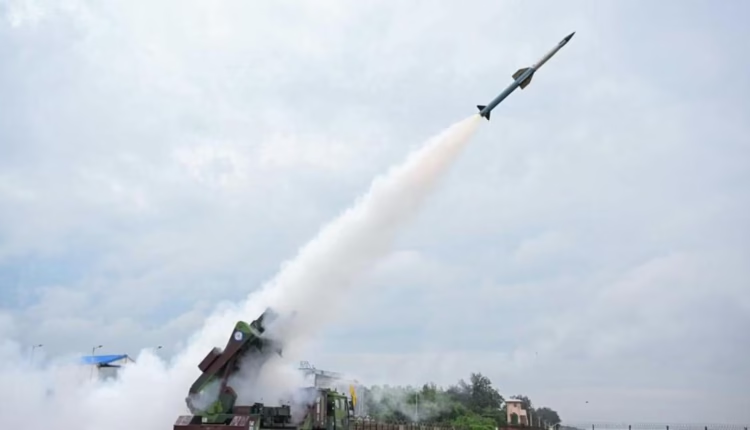(DRDO) successfully conducted the maiden flight tests of the Integrated Air Defence Weapon System (IADWS)
In a landmark achievement for India’s defence capabilities, the Defence Research and Development Organisation (DRDO) successfully conducted the maiden flight tests of the Integrated Air Defence Weapon System (IADWS) on Sunday afternoon.
The tests took place off the Odisha coast around 12:30 PM, marking a crucial milestone in India’s ambitious plan to create a homegrown, multi-domain security shield under Mission Sudarshan Chakra, a project envisioned to be fully operational by 2035.
A Milestone in India’s Pursuit of a Self-Reliant Security Grid
The Ministry of Defence, in a statement, hailed the IADWS as a state-of-the-art, multi-layered air defence system built entirely with indigenous technologies. The system integrates:
- Quick Reaction Surface-to-Air Missiles (QRSAM) for medium-range interception,
- Advanced Very Short Range Air Defence System (VSHORADS) for close-range engagements, and
- A high-power, laser-based Directed Energy Weapon (DEW), a futuristic asset designed to neutralise aerial threats with pinpoint precision.
Together, these systems are intended to form the backbone of Mission Sudarshan Chakra, a networked, multi-layered defensive shield designed to counter a wide range of enemy attacks—from long-range ballistic missiles and fighter jets to drones and cyber warfare threats—safeguarding India’s critical infrastructure and borders.
Mission Sudarshan Chakra: Vision of a Multi-Layered Defence Shield
The successful test comes just days after Prime Minister Narendra Modi, in his Independence Day address, announced the formal launch of Mission Sudarshan Chakra.
The mission aims to integrate air defence, cyber capabilities, and advanced surveillance systems into a seamless security grid, ensuring India’s ability to preempt and neutralise evolving threats.
This initiative builds upon lessons learned from previous conflicts, such as the missile and drone interception operations following Operation Sindoor, where Indian air defences proved their mettle.
Systems like the S-400 Triumf, Barak 8 MRSAM, and the indigenous Akash surface-to-air missile were deployed effectively to thwart hostile strikes.
Cutting-Edge Integration of DRDO’s Research and Defence Assets
The IADWS represents the integration of multiple indigenous systems into a single, highly coordinated defensive network.
A Centralised Command and Control Centre, developed by the Defence Research & Development Laboratory (DRDL), coordinates real-time threat detection, targeting, and weapon deployment.
The VSHORADS was designed and developed by the Research Centre Imarat (RCI), while the Directed Energy Weapon was built by the Centre for High Energy Systems and Sciences (CHESS).
Together, these cutting-edge systems showcase India’s technological leap in missile and energy-based defence solutions.
Flawless Demonstration of Combat-Ready Capabilities
During the flight trials, the IADWS demonstrated its precision and reliability by successfully engaging three distinct aerial targets:
- Two high-speed, fixed-wing UAVs simulating enemy aircraft,
- A multi-copter drone representing low-altitude and stealth threats.
Each target was successfully tracked, intercepted, and destroyed by QRSAM, VSHORADS, and the laser-based DEW at different ranges and altitudes.
All components—radars, communication links, missile launchers, and the laser weapon system—functioned flawlessly, according to data recorded by instruments deployed at the Integrated Test Range (ITR), Chandipur.
Strengthening India’s Defence Ecosystem
Defence Minister Rajnath Singh praised DRDO scientists and the private sector partners involved in the program, calling the test a “historic validation of India’s multi-layered air defence capability.”
He emphasised that the IADWS would play a vital role in strengthening area defence around key military installations, government assets, and strategic infrastructure against aerial threats.
DRDO Chairman Dr. Samir V. Kamat congratulated all teams involved, highlighting that this achievement reflects India’s growing self-reliance in developing next-generation military technology.
A Strategic Leap Towards Future Warfare
The IADWS program demonstrates that India is steadily transitioning from a weapons importer to a global defence innovator. By incorporating laser-based directed energy weapons alongside missile defence systems, India is taking a giant leap toward future warfare readiness, preparing to face complex multi-domain threats in an increasingly volatile global security environment.
The integration of these systems with the Indian Air Force’s Integrated Air Command and Control System (IACCS) and the Indian Army’s Akashteer network will create a truly unified air defence network that can adapt to any scenario—from high-speed missile strikes to drone swarms and beyond.
#DRDO #MissionSudarshanChakra #IADWS #DefenceTechnology #AirDefence #DirectedEnergyWeapons #IndiaDefence #MakeInIndia #MilitaryInnovation #RajnathSingh #SamirVKamat #BreakingNews #IndiaSecurity #IndigenousTechnology #FutureWarfare

